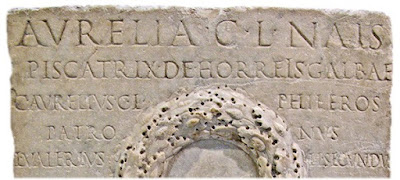Translation in the comments
Graecī Tenedum*, quae est īnsula, nāvigāvērunt et Trōiānī equum ligneum in oppidum portāvērunt. Inde noctū Graecī Trōiam nāvigant et virī, quī sunt in equō, portās oppidī aperiunt, dum Troiānī dormiunt. Graecī Troiānōs multōs vulnerāvērunt et necāvērunt et oppidum vastāvērunt.
*Tenedus, -ī [2/f]: island off the coast of Troy; from
Ancient Greek Τένεδος (Ténedos)
qui, quae, quod
This is just a brief note since the topic will be covered in detail later.
From this passage and the previous one:
- Graecī Tenedum, quae est īnsula, nāvigāvērunt.
- Equum magnum et ligneum aedificant, quem virīs complent.
- Virī, quī sunt in equō, portās oppidī aperiunt.
These are examples of relative pronouns; they
introduce a relative clause and refer to the person or thing in the main
clause:
Graecī Tenedum, ¦ quae est īnsula, [relative clause] ¦ nāvigāvērunt.
│ The Greeks sailed to Tenedos, which is an island.
Equum magnum et ligneum aedificant, ¦ quem
virīs complent. [relative clause] │ They
build a large and wooden horse which they fill with men.
Virī, ¦ quī sunt in equō, [relative clause] ¦
portās oppidī aperiunt. │ The men who are in the horse open the gates of
the town.
The nominative singular forms of the relative pronouns are:
qui (masculine), quae (feminine), quod (neuter)
The person or thing they refer to is known as the antecedent;
in the examples:
- …Tenedum [antecedent], quae est īnsula │Tenedos, which is an island
- Equum [antecedent] … quem virīs complent. │ A horse … which they fill with men.
- Virī [antecedent], quī sunt in equō,… │ The men, who are in the horse …
Two points to note:
[1] the relative pronoun agrees in gender and number with
its antecedent
[2] the case of the relative pronoun depends on its use
within the relative clause:
[i] Videō puellam ¦ [ii] quae in rēgiā habitat. │ I see a
girl ¦ who lives in a palace.
[i] Main clause: Videō puellam; accusative case because puella
is the direct object of videō
Relative clause: …quae in rēgiā habitat; it agrees
with the gender and number of puella i.e. feminine singular, but it is
in the nominative case because “who lives in a palace” refers to what
the girl does i.e. quae is the subject of the relative clause.
[i] Liber ¦ quem puellae dedī ¦ [i] bonus est. │ The book
¦ which I gave to the girl ¦ is good.
[i] Liber …bonus est; liber is in the nominative case
because it is the subject of the main clause
[ii] …quem puellae dedī; it agrees with the gender and number
of liber i.e. masculine singular, but it is in the accusative case
because it is the direct object of the relative clause ‘which I gave’
More information on the relative pronouns at this stage can
be found at:
https://www.thelatinlibrary.com/101/RelativePronouns.pdf
The Greeks sailed to Tenedos, which is an island, and the
Trojans carried the wooden horse into the town. Thence the Greeks sail(ed) by
night to Troy, and the men who are / were in the horse open(ed) the gates of
the town while the Trojans sleep / slept. The Greeks injured and killed many
Trojans and laid waste the town.










































